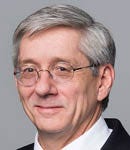Partnership Guides Trash Win-Win for Air Force Base and Maryland County
U.S. Air Force civil engineer Steven Zander had planned on spending his retirement breaking wild horses with his daughter in Georgia. Then the Pentagon called again.
Now, the 62-year-old is roping trash instead. Wrangling refuse is just a slice of his newest career directing the Air Force Community Partnership Program, which began in late 2012. It’s designed to help bases and their neighbors share services and save money.
One of his signature projects streamlines delivery of the 4,000 tons of garbage Maryland’s Joint Base Andrews generates annually to a Prince George’s County landfill in its own back yard. Ordinarily, tipping fees over five years would reach nearly $1 million. However, the partnership pact sealed in June 2014 drops that price by a total of $280,000. That’s a savings of close to 25 percent for the base that’s home to the president’s Air Force One.

Steven Zander
“Whether it’s waste, how we treat water or how we do medical training, we have aha moments all of the time,” Zander says. “That’s one of the things we’re finding when we get different leaders together to talk. They say ‘Here’s what we’re doing.’ And others can ask, ‘What are you doing that for?’ We want to make every dollar count.”
In just three years, the partnership has identified 1,000-plus sharing initiatives at 51 bases nationwide, he says. Refuse collection, wastewater treatment, snow removal, youth activities, library services and athletic field construction are among the 115 projects launched thus far.
For his diligence, Zander has been selected as one of 30 finalists for a prestigious Service to America award honoring federal workers who break down barriers and make a lasting difference. “Sammies,” called the Oscars of government service, are handed out each autumn to top employees nominated in seven different categories. Zander was chosen in the field of management excellence.
Before Zander helped to guide the agreement between Joint Base Andrews and Prince George’s County, waste haulers contracted by the base were trucking garbage all over the Washington region. The new destination, Brown Station Landfill, is a nine-mile trip.
Adam Ortiz, director of the county’s Department of Environment, was thrilled to negotiate with an institutional partner by offering a bulk discount for guaranteed tonnage. It’s the county’s first dive into such a venture—and Ortiz doesn’t want it to be the last.
“We still get revenue, plus this means fewer truck miles, less pollution, less traffic, and they’re helping to provide jobs to our local economy,” Ortiz says. “A landfill is basically a big box. I’d rather fill it in a way that benefits our community and provides a win-win for participants.”
The next frontier, he says, is to expand the agreement to include recycling and compost from the base. Statewide, Prince George’s County ranks No. 1 in waste diversion and No. 2 in recycling.
“All of us inherit systems that may be inefficient, costly and needlessly unsustainable,” Ortiz says, noting that a partnership mentality can flip that thinking. “We’re all in the Prince George’s family and it’s in our mutual interest to work together.”
Paul Holland, community planning liaison with Andrews, emphasizes that the garbage agreement is just one piece of an effort to close the military-civilian gap common across the country. Prince George’s County and the base also have collaborated on a charter school and training for firefighters and emergency response dispatchers.
“This is not just about monetary benefits,” Holland says. “It’s how we can strengthen relationships.”
Recently, the base started contributing to a local food bank by donating edibles from the commissary that were once destined for the Dumpster.
“It’s one way we can reduce our trash footprint,” Zander says about how the Air Force values eco-stewardship. “We have great environmental programs.”
The Sammie nomination was a total surprise, he says. A 17-member selection committee comprised of movers and shakers representing government, business, entertainment, media and the non-profit community will soon be choosing this year’s seven Sammie winners as well as a federal employee of the year. The awards are named for Samuel J. Heyman, the late founder of the non-profit, non-partisan Partnership for Public Service who heeded President Kennedy’s call to serve in 1963.
“It was very humbling to be chosen,” Zander says, “especially when I see all of the amazing things people are doing out there.”
True to his nature, he shined the spotlight on other participants in the Air Force Community Partnership Program.
“It was those communities and institutional leaders who provided the creative juices,” he says. “We just bring the expertise to help them along.”
About the Author
You May Also Like


